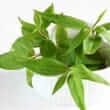Background
- Fo-ti (Chinese name: he-shou-wu) is a plant native to China, where it continues to be widely grown. It also grows extensively in Japan and Taiwan. Fo-ti has a history of reversing and preventing the effects of aging.
- Fo-ti is available in both unprocessed and processed forms. Unprocessed fo-ti (also known as "white" fo-ti because its color is usually much lighter than the processed form) is taken by mouth for its laxative effect. Topically (applied on the skin), unprocessed fo-ti is used to treat skin conditions such as acne, athlete's foot, dermatitis, razor burn, and scrapes. Processed fo-ti, also known as "red" fo-ti because it is much darker in color than the unprocessed variety, is used to prevent or delay heart disease by blocking the formation of plaque in blood vessels.
- Currently, there are no high-quality human trials available supporting the use of fo-ti for any indication.
References
Natural Standard developed the above evidence-based information based on a thorough systematic review of the available scientific articles. For comprehensive information about alternative and complementary therapies on the professional level, go to . Selected references are listed below.
- But PP, Tomlinson B, Lee KL. Hepatitis related to the Chinese medicine Shou-wu-pian manufactured from Polygonum multiflorum. Vet.Hum.Toxicol. 1996;38(4):280-282.
View Abstract - Chan YC, Wang MF, Chang HC. Polygonum multiflorum extracts improve cognitive performance in senescence accelerated mice. Am.J.Chin Med. 2003;31(2):171-179.
View Abstract - Chan YC, Wang MF, Chen YC, et al. Long-term administration of Polygonum multiflorum Thunb. reduces cerebral ischemia-induced infarct volume in gerbils. Am.J.Chin Med. 2003;31(1):71-77.
View Abstract - Chen J. [An experimental study on the anti-senility effects of shou xing bu zhi]. Zhong.Xi.Yi.Jie.He.Za Zhi. 1989;9(4):226-7, 198.
View Abstract - Horikawa, K., Mohri, T., Tanaka, Y., and Tokiwa, H. Moderate inhibition of mutagenicity and carcinogenicity of benzo[a]pyrene, 1,6-dinitropyrene and 3,9-dinitrofluoranthene by Chinese medicinal herbs. Mutagenesis 1994;9(6):523-526.
View Abstract - Liu C, Zhang Q, Lin J. [Effect of the root of Polygonum multiflorum Thunb. and its processed products on fat accumulation in the liver of mice]. Zhongguo Zhong.Yao Za Zhi. 1992;17(10):595-6, 639.
View Abstract - Mazzanti G, Battinelli L, Daniele C, et al. New case of acute hepatitis following the consumption of Shou Wu Pian, a Chinese herbal product derived from Polygonum multiflorum. Ann.Intern.Med. 4-6-2004;140(7):W30.
View Abstract - Oerter Klein K, Janfaza M, et al. Estrogen bioactivity in fo-ti and other herbs used for their estrogen-like effects as determined by a recombinant cell bioassay. J Clin Endocrinol.Metab 2003;88(9):4077-4079.
View Abstract - Park GJ, Mann SP, Ngu MC. Acute hepatitis induced by Shou-Wu-Pian, a herbal product derived from Polygonum multiflorum. J.Gastroenterol.Hepatol. 2001;16(1):115-117.
View Abstract - Unger M, Frank A. Simultaneous determination of the inhibitory potency of herbal extracts on the activity of six major cytochrome P450 enzymes using liquid chromatography/mass spectrometry and automated online extraction. Rapid Commun.Mass Spectrom. 2004;18(19):2273-2281.
View Abstract - Zhang CZ, Wang SX, Zhang Y, et al. In vitro estrogenic activities of Chinese medicinal plants traditionally used for the management of menopausal symptoms. J Ethnopharmacol 4-26-2005;98(3):295-300.
View Abstract







